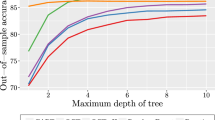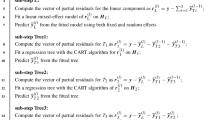Abstract
In many applications, the presence of interactions or even mild non-linearities can affect inference and predictions. For that reason, we suggest the use of a class of models laying between statistics and machine learning and we propose a learning procedure. The models combine a linear part and a tree component that is selected via an evolutionary algorithm, and they can be adopted for any kinds of response, such as, for instance, continuous, categorical, ordinal responses, and survival times. They are inherently interpretable but more flexible than standard regression models, as they easily capture non-linear and interaction effects. The proposed genetic-like learning algorithm allows avoiding a greedy search of the tree component. In a simulation study, we show that the proposed approach has a performance comparable with other machine learning algorithms, with a substantial gain in interpretability and transparency, and we illustrate the method on a real data set.



Similar content being viewed by others
References
Back T (1996) Evolutionary algorithms in theory and practice: evolution strategies, evolutionary programming, genetic algorithms. Oxford University Press
Benjamini Y (2010) Simultaneous and selective inference: current successes and future challenges. Biom J 52(6):708–721
Berk R, Brown L, Buja A, Zhang K, Zhao L (2013) Valid post-selection inference. Ann Stat 41(2):802–837
Breiman L (2001) Random forests. Mach Learn 45(1):5–32
Breiman L (2001) Statistical modeling: the two cultures (with comments and a rejoinder by the author. Stat Sci 16(3):199–231
Breiman L, Friedman J, Stone CJ, Olshen RA (1984) Classification and regression trees. CRC Press
Chatterjee S, Laudato M, Lynch LA (1996) Genetic algorithms and their statistical applications: an introduction. Comput Stat Data Anal 22(6):633–651
Chipman HA, George EI, McCulloch RE et al (2010) Bart: Bayesian additive regression trees. Ann Appl Stat 4(1):266–298
Claeskens G, Hjort NL et al (2008) Model selection and model averaging. Cambridge Books
Conversano C, Dusseldorp E (2017) Modeling threshold interaction effects through the logistic classification trunk. J Classif 34(3):399–426
Cox DR (1975) A note on data-splitting for the evaluation of significance levels. Biometrika 62(2):441–444
Davison AC (2003) Statistical models, vol 11. Cambridge University Press
Doshi-Velez F, Kim B (2017) Towards a rigorous science of interpretable machine learning. arXiv preprint arXiv:1702.08608
Dusseldorp E, Meulman JJ (2004) The regression trunk approach to discover treatment covariate interaction. Psychometrika 69(3):355–374
Dusseldorp E, Conversano C, Van Os BJ (2010) Combining an additive and tree-based regression model simultaneously: STIMA. J Comput Graph Stat 19(3):514–530
Efron B (2020) Prediction, estimation, and attribution. J Am Stat Assoc 115(530):636–655
Fan G, Gray JB (2005) Regression tree analysis using target. J Comput Graph Stat 14(1):206–218
Fithian W, Sun D, Taylor J (2014) Optimal inference after model selection. arXiv preprint arXiv:1410.2597
Friedman JH (1991) Multivariate adaptive regression splines. Ann Stat 19(1):1–67
Geurts P, Ernst D, Wehenkel L (2006) Extremely randomized trees. Mach Learn 63(1):3–42
Gottard A, Vannucci G, Marchetti GM (2020) A note on the interpretation of tree-based regression models. Biom J 62(6):1564–1573
Grubinger T, Zeileis A, Pfeiffer K-P (2014) evtree: evolutionary learning of globally optimal classification and regression trees in R. J Stat Softw 61(1):1–29
Guidotti R, Monreale A, Ruggieri S, Turini F, Giannotti F, Pedreschi D (2018) A survey of methods for explaining black box models. ACM Comput Surv (CSUR) 51(5):93
Hothorn T, Hornik K, Zeileis A (2006) Unbiased recursive partitioning: a conditional inference framework. J Comput Graph Stat 15(3):651–674
Loh W-Y (2002) Regression tress with unbiased variable selection and interaction detection. Statistica Sinica 12:361–386
Meyer MC (2003) An evolutionary algorithm with applications to statistics. J Comput Graph Stat 12(2):265–281
Molnar C, König G, Herbinger J, Freiesleben T, Dandl S, Scholbeck CA, Casalicchio G, Grosse-Wentrup M, Bischl B (2020) Pitfalls to avoid when interpreting machine learning models. arXiv preprint arXiv:2007.04131
Murthy SK, Kasif S, Salzberg S (1994) A system for induction of oblique decision trees. J Artif Intell Res 2(1):1–32
R Core Team (2021) R: a language and environment for statistical computing. R Foundation for Statistical Computing, Vienna, Austria
Rudin C, Radin J (2019) Why are we using black box models in ai when we don’t need to? a lesson from an explainable ai competition. Harvard Data Sci Rev 1(2). https://doi.org/10.1162/99608f92.5a8a3a3d
Shmueli G et al (2010) To explain or to predict? Stat Sci 25(3):289–310
Sutton RS, Barto AG, et al (1998) Reinforcement learning: an introduction. MIT Press
Voigt P, Von dem Bussche A (2017) The EU general data protection regulation (GDPR). In: A practical guide, 1st edn. Springer, Cham, vol 10, p 3152676
Wermuth N, Cox DR et al (1998) On association models defined over independence graphs. Bernoulli 4(4):477–495
Zhu R, Zeng D, Kosorok MR (2015) Reinforcement learning trees. J Am Stat Assoc 110(512):1770–1784
Author information
Authors and Affiliations
Corresponding author
Ethics declarations
Conflict of interest
The authors declare that they have no conflict of interest.
Additional information
Publisher's Note
Springer Nature remains neutral with regard to jurisdictional claims in published maps and institutional affiliations.
Rights and permissions
Springer Nature or its licensor (e.g. a society or other partner) holds exclusive rights to this article under a publishing agreement with the author(s) or other rightsholder(s); author self-archiving of the accepted manuscript version of this article is solely governed by the terms of such publishing agreement and applicable law.
About this article
Cite this article
Vannucci, G., Gottard, A. An evolutionary estimation procedure for generalized semilinear regression trees. Comput Stat 38, 1927–1946 (2023). https://doi.org/10.1007/s00180-022-01302-8
Received:
Accepted:
Published:
Issue Date:
DOI: https://doi.org/10.1007/s00180-022-01302-8




